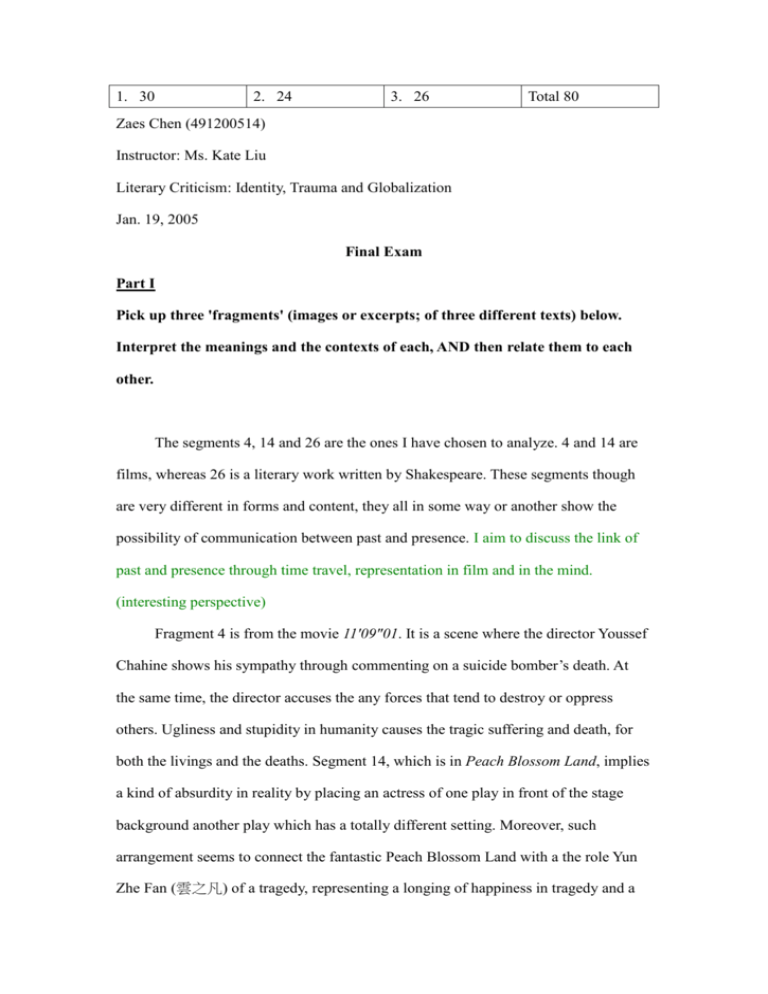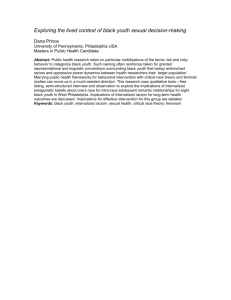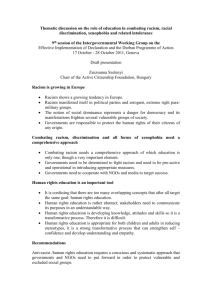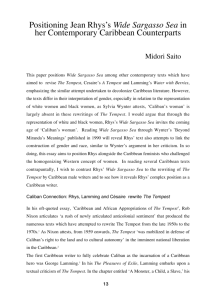Zaes Chen (491200514)
advertisement

1. 30 2. 24 3. 26 Total 80 Zaes Chen (491200514) Instructor: Ms. Kate Liu Literary Criticism: Identity, Trauma and Globalization Jan. 19, 2005 Final Exam Part I Pick up three 'fragments' (images or excerpts; of three different texts) below. Interpret the meanings and the contexts of each, AND then relate them to each other. The segments 4, 14 and 26 are the ones I have chosen to analyze. 4 and 14 are films, whereas 26 is a literary work written by Shakespeare. These segments though are very different in forms and content, they all in some way or another show the possibility of communication between past and presence. I aim to discuss the link of past and presence through time travel, representation in film and in the mind. (interesting perspective) Fragment 4 is from the movie 11'09"01. It is a scene where the director Youssef Chahine shows his sympathy through commenting on a suicide bomber’s death. At the same time, the director accuses the any forces that tend to destroy or oppress others. Ugliness and stupidity in humanity causes the tragic suffering and death, for both the livings and the deaths. Segment 14, which is in Peach Blossom Land, implies a kind of absurdity in reality by placing an actress of one play in front of the stage background another play which has a totally different setting. Moreover, such arrangement seems to connect the fantastic Peach Blossom Land with a the role Yun Zhe Fan (雲之凡) of a tragedy, representing a longing of happiness in tragedy and a lost of happiness in the comedy. Fragment 26 is about Gonzolo’s description of a Platonic Utopia, where equality, peace and all lovely virtue is found except trace of civilization. This description is very interesting and ironic to human progress in history. (How is this related to time travel) As I have mentioned, in these three fragments, some communication is made between past and presence. In segment 4 director through time travel brings audience with him to a represented past. By trying to be in the place in person, audience can analyze 911 incident through their observation instead of second-hand news. Though the film itself is virtually a second-hand information, Youssef Chahine shows the idea of understanding the so-called truth through be in the past by attempt to represent a period in the past. On the other hand, Lai Sheng Chuan (賴聲川), the director of Peach Blossom Land place two different time frames on a stage. Though the setting varies, the lines spoken by actors and actresses in different plays blend into each other and form a harmonious, complete dialogue. This harmonious atmosphere also shows in the fragment 14. By just examining this scene, it is really hard to tell the peach blossom land background is not the really setting for the actress. This blending proves the communication between two different time frames is possible. The text of The Tempest, instead of bringing readers into past or showing different time frames in one dimension, it embodies the communication regardless of time frame since its existence is already a past in presence. When I was in the class listening to teacher teaching about some concepts which might be involved or revealed in The Tempest, such as colonialism, I found out that analyzing a text is actually a one-way communication. Critics receive the message from past and interpreted based on their contemporary discourse. All three segments imply the possibility of communication regardless of the time frame. However, they contain different understanding of the influence of communication. Youssef Chahine states the importance to attempt to explore the truth in the past(or understanding a pattern of repetition of human follies?), while at the same time he also claims it is impossible to really represent (?) or redone(un-do) the past, by clicking the mouse to rewind the collapsing of twin towers clip. Lai Sheng Chuan, on contrary, shows the confusion and chaos in communication in two time frames. Though communication can be made, such communication could still be brief, confusing and unrealistic. (Oh, well, I don’t find the juxtaposition confusing. While some characters—江濱柳 and the director--are obsessed by the past, some move on. The juxtaposition, for me, shows the ironies in the characters’ obsession with the past/ideal and blindness to the present.) The Tempest embodies the capability of crossing time frame communication, but only in a merely one-way communication.(This is what I don’t agree with. Gonzalo merely projects an ideal world of innocence—nothing to do with the past.) In conclusion, representation and the existence of the past (such as literary works) leads to the communication regardless of time frames and might broaden people’s perception, although representation can never be complete and the things from the past could be interpreted differently. Part II I. History, New Historicism, Postcolonialism and Identity 2. Racism and its Consequences/Resistance: How is colonialism and racial discrimination justified by discourses of racism and racial stereotypes? Use two of the following texts to discuss examples of racism and racial stereotypes and their influences--then give some examples of the racism happening in our society. In both The Tempest and Save the Last Dance racial discrimination is being justified by discourses of racism and racial stereotypes. (Your analysis here is too brief; it does not show 1) the ways racism is justified by stereotypes in The Tempest, 2) the subtle form of racism in having a token success in a group of blacks.) In The Tempest, Caliban who has an inhuman appearance is often being taken as a symbol of minority group.(too broad) However, appearance is often the most significant difference between races that might leads to discrimination. It leads to Caliban’s negative characterization in The Tempest. It is apparent that people hardly feel sympathized with Caliban because of his appearance, or all the other characters’ rude attitude toward him. From the dialogue of other characters, it is apparent that from the first sight they saw Caliban they have already exclude the possibility of communicating with him on an equal stand, because of his appearance which is different from theirs. Prospero might be the one that have treated Caliban nicely, but his intention of the initial kindness is really doubtful, not to mention his rude attitude afterwards. In this discourse of racism, even Caliban is aware of his inferiority. Personally, I looked at Caliban’s ironic actions of sometimes claiming his original sovereignty over the island and sometimes worshipping clowns like gods as the struggling about his identity. Sometimes we can see Caliban enjoy the human as their servant and sometimes rebellious. It is a case of discrimination justified by discourse. The racial discrimination shown in Save the Last Dance, on other hand is justified by stereotypes. Most black characters inside the film fit into the stereotypes. Males are violent gangsters who may be criminals, whereas females are prone to be involved in pre-marriage pregnancy or other social problems. By characterizing Derek who was a hard working student in contrast with other black characters, the film justified the discrimination by attribute the low social status of black people to their individuals’ problem. The happy ending of the film seems to claims that black people can still be in successful in society as long as they want to. It is a fallacious statement regardless of the difficulties black people face in the discourse of racism. Furthermore, under the discourse of racism, black they face the difficulty of whether in they should converge with white people’s identity. The film portrays the black people diverge themselves from the white culture by language, school and community. Showing Derek’s success sets off on contrary the tragic condition of the rest in such community, which is really unacceptable. Does converge with white people stands for better life or success? It is really doubtable. In our society, racism can be found by comparing Taiwanese’s different attitude toward White people and foreign labors from Southeast Asia. When a Taiwanese is talking with foreigner with white appearance, they would try their best speak in English no matter how poor their English is. However, when meeting a foreign labors from Southeast Asia or people who has such stereotype appearance, Taiwanese always insist on speaking in Taiwanese or Mandarin, not even willing to at least greeting with “Sa-wa-di-ka”. It is quite apparent the problem lies not really in the language proficiency but the attitude. Even if language is a factor, it only further proved that racism is reflected on the selection of language to learn. Under this discourse of racism, Southeastern foreign labors have to learn Mandarin or Taiwanese, while foreigners with white skin can live in Taiwan with little difficulty in communicating. Group Question-Zaes, Christina II. Postmodernism, Globalization and Trauma 3. Hybridity: Do the hybrid signs deny or allow constructions of identity? In other words, is hybridity empowering, disrupting or disintegrating our sense of identities? I. Introduction A. Hibridity: construction of identity, instead of denying (yes and no—right?) B. The process: both construction & deconstruction = Reconstruction (Struggle) C. Result: can reconstruct a new identity or enhance the original identity II. Bamboozled A. Black face: discriminating production of white culture B. Exaggerating makes it hybridity C. Manray struggling → enhanced original identity D. Uncle Tom, Mammy III. City of Sadness A. Language: Japanese, Mandarin, Taiwanese, Chinese Wu, Guantonese B. Japanese Flags: C. Identity of “祖國” (Fatherland): 1. 「回到祖國的懷抱,當然嘛很好 」↔「國旗有掛上也有掛下的」 2.「生離祖國,死歸祖國,死生天命,無想無念」 、 「當我已死﹐我的人已 屬於祖國美麗的將來」↔ revolt the political power from 祖國 D. Intellectuals (Marxism books) IV. Hollywood Hong Kong negative form of hybridity, right? A. Hollywood: 1. Accepting without consciousness (e.g. McDonald’s in Taiwan) 2. Gap between Hollywood and Da-Kan Village B. Hong Hong: Shanghai –> Hong Kong—> US V. Examples in Taiwan A. McDonalds (Hello Kitty wearing Chinese Costumes) B. Spring Festival Couplets (春聯) with English on C. The Tempest in Chinese Drama VI. Conclusion A. Caused by Immigration and Globalization B. Hybridity causes reconstruction of identity 1. might arouse awareness → struggle 2. might not …just accept unconsciously C. Self-awareness of hibridity in the films: Bamboozled > City of Sadness > Hollywood, Hong Kong A good example of positive form of hybridity is 五佰’s ‘台灣製造.’









